Tag: art
Angels and devils
11 June 2015 | This 'n' that
A new website explores the work of artist Hugo Simberg
Two small boys carry a wounded angel; a farmer’s wife gives milk to a little devil and her twins; skeletons tend the plants in the Garden of Death. The mythical figures that populate the paintings of the symbolist artist Hugo Simberg (1873-1917) have a wayward and macabre charm that is all their own.
The Helsinki Ateneum Art Museum’s new website, The Other World of Hugo Simberg, offers an opportunity to explore Simberg’s life and work. Showcasing twelve of his best-known paintings, it lays a trail through associated visual and textual material – different versions of the works, photographs, sketches, letters….
If you’ve ever wondered what Simberg’s characters might be thinking or saying, the website also gives you the opportunity to provide thought or speech bubbles, which can then be uploaded to the website.
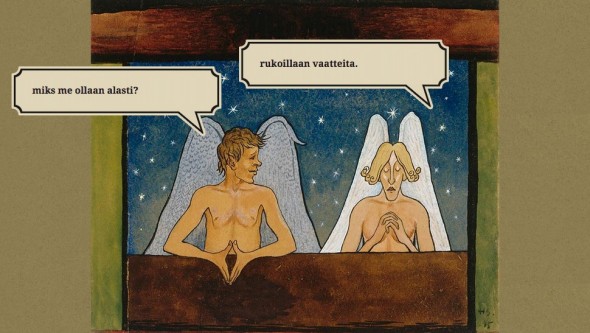
Angelic meetings: ‘Why are we naked?’ ‘Let’s pray for clothes!’ (above); ‘Do you come here often?’ (below).
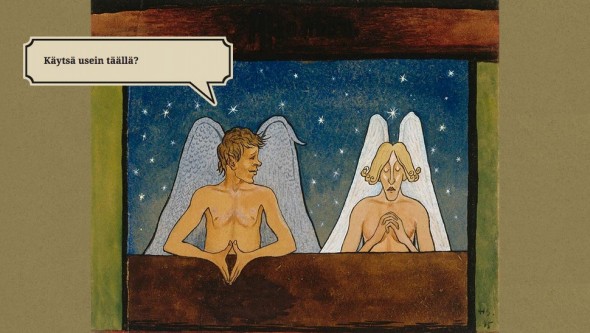
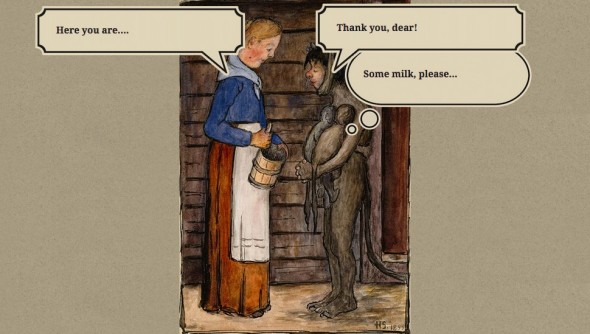
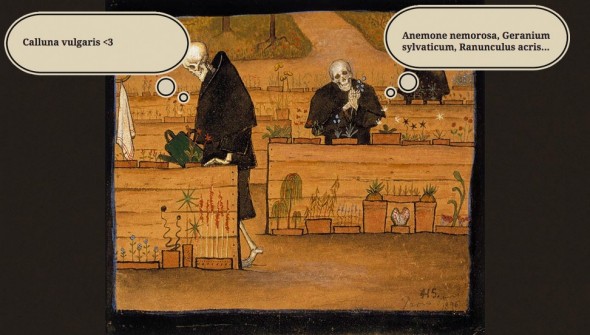
Kaisa Koivisto & Uta Laurén: Suomalaisen taidelasin kultakausi [The golden era of the Finnish glass]
19 March 2015 | Mini reviews, Reviews
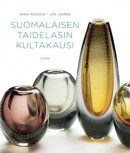 Suomalaisen taidelasin kultakausi
Suomalaisen taidelasin kultakausi
[The golden era of the Finnish glass]
Helsinki: Tammi, 2014. 326 pp., ill.
ISBN 978-951-31-7320-3
€49.90, hardback
The authors of this book specialise in Finnish glass and its history, working at the Finnish Glass Museum. The 1950s and the early 1960s formed the golden age of Finnish glass: young artists such as Timo Sarpaneva, Tapio Wirkkala, Gunnel Nyman, Nanny Still and Kaj Franck all began gaining fame as the number of prizes won at the 1950s Milan triennales made way for their international success. Finnish glass factories worked closely with artists, as serial production had to provide the commercial success. In the 1970s, however, the glass industry began to diminish due to heavy competition in the form of imported glassware. Unique objects of glass are still made and glass artists trained in Finland, but of six major factories only Iittala (est. 1881) is still working; for example, the 220-year old Nuutajärvi Glass Factory closed its doors in 2013. The majority of the excellent photographs in this comprehensive, beautiful book are from the Finnish Glass Museum or the Finnish Design Museum. The book includes short biographies of 27 Finnish glass artists and histories of glassworks as well as a glossary of glass-making terms.
Fiat Lux!
31 December 2014 | This 'n' that
 Time for Lux Helsinki light event again: the January 2014 festival (see photos here) brought 150,000 visitors from Helsinki, the rest of Finland and around the world to the city. It is organised by the City of Helsinki.
Time for Lux Helsinki light event again: the January 2014 festival (see photos here) brought 150,000 visitors from Helsinki, the rest of Finland and around the world to the city. It is organised by the City of Helsinki.
The artworks – 17 of them – will be on display in 13 places around the centre of Helsinki, from the courtyard of the Tori Quarters to Finlandia Hall. The light and media artists and sound designers come from Finland, Germany, France, Belgium and Japan.
Lux Helsinki is also part of as the International Year of Light and Light-based Technologies of the United Nations in 2015.
Darkness will slowly diminish, and there will be more light: it’s great that Helsinki winter – at times white with snow, at times not – will again (thanks to artists and the latest technology) be filled with colour for a while. Let light be made!
To write, to draw
18 December 2014 | This 'n' that
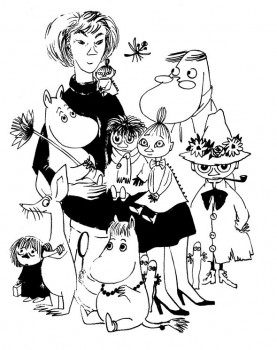
Self-portrait: Tove Jansson with her creations. Picture: @Moomin Characters™
A new Finnish biography of Tove Jansson (1914–2001) was published in 2013; the artist and creator of the Moomins has been celebrated in 2014 in her centenary year. Tove Jansson. Tee tytötä ja rakasta by Tuula Karjalainen was published in English this autumn, translated by David McDuff, under the title Tove Jansson: Work and Love (Penguin Global, Particular Books).
The book was reviewed by The Economist newspaper on 22 November. Unsurprisingly, according to the review, Jansson was more interesting as a writer than as a painter:
’Jansson always saw herself first as a serious painter. She exhibited frequently in Finland, and won awards and commissions for large public murals. Her reputation there as a writer lagged far behind the rest of the world. Ms Karjalainen is a historian of Finnish art, and although she covers Jansson’s writing, it is the paintings that really interest her. This is a pity. Jansson was a more interesting writer than a painter, and her life sheds much light on her particular quality as a storyteller.’
Whereas Karjalainen concentrates on Jansson’s painting, another biography of Jansson, by the Swedish literary scholar Boel Westin (reviewed here) focuses on Jansson as a writer. Here, you can find a selection of Tove Jansson’s art.
A quotation from The Economist‘s review: ‘Her use of Moomins to defy the war is characteristic. Everywhere in her fiction there is the same sense of deflection and indirection. She hated ideologies, messages, answers. And it somehow fits that she fell in love with both men and women. Ambivalence was a kind of comfort to her. As one of her characters says, “Everything is very uncertain, and that is what makes me calm.’
Tove Jansson’s versatile brilliance as an artist, we think, is at its best in the way she combined illustration and text in her Moomin stories. Their (great) visual and philosophical value lies in the praise of freedom and independence of the mind: for everyone, young or old.
Letters from Tove
6 October 2014 | Extracts, Non-fiction
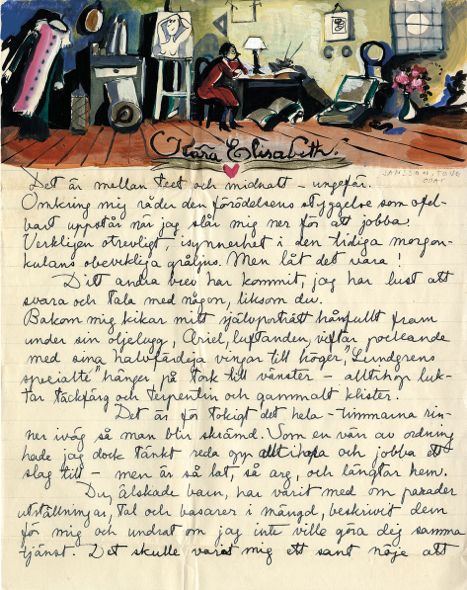
Early days: Tove Jansson went to Stockholm to study art when she was just 16. A letter to her friend Elisabeth Wolff, from November 1932
Artist and author Tove Jansson (1914–2001) is known abroad for her Moomin books for children and fiction for adults. A large selection of her letters – to family, friends and lovers – was published for the first time in September. In these extracts she writes to her best friend Eva Konikoff who moved to the US in 1941, to her lover, Atos Wirtanen, journalist and politician, and to her life companion of 45 years, artist Tuulikki Pietilä.
Brev från Tove Jansson (selected and commented by Boel Westin and Helen Svensson; Schildts & Söderströms, 2014; illustrations from the book) introduced by Pia Ingström
7.10.44. H:fors. [Helsinki]
exp. Tove Jansson. Ulrikaborgg. A Tornet. Helsingfors. Finland. Written in swedish.
to: Miss Eva Konikoff. Mr. Saletan. 70 Fifty Aveny. New York City. U.S.A.
Dearest Eva!
Now I can’t help writing to you again – the war [Finnish Continuation War, from 1941 to 19 September 1944] is over, and perhaps gradually it will be possible to send letters to America. Next year, maybe. But this letter will have to wait until then – even so, it will show that I was thinking of you. Curiously enough, Konikova, all these years you have been more alive for me than any of my other friends. I have talked to you, often. And your smiling Polyfoto has cheered me up and comforted me and has also taken part in the fortunate and wonderful things that have happened. I remembered your warmth, your vitality and your friendship and felt happy! At first I wrote frequently, every week – but after about a year most of it was returned to me. I wrote more after that, but the letters were often so gloomy that I didn’t feel like saving them. Now there are so absurdly many things I have to talk to you about that I don’t know where to begin. Koni, if only I’d had you here in my grand new studio and could have hugged you. After these recent years there is no human being I have longed for more than you. More…
The painter who wrote
6 October 2014 | Non-fiction, Reviews
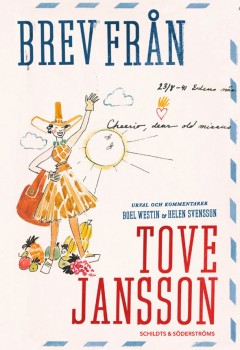 Brev från Tove Jansson
Brev från Tove Jansson
Urval och kommentarer Boel Westin & Helen Svensson
[Letters from Tove Jansson, selected and commented by Boel Westin & Helen Svensson]
Helsingfors: Schildts & Söderströms, 2014. 491 pp., ill.
ISBN 978-951-52-3408-7
€34.90
In Finnish (translated by Jaana Nikula):
Kirjeitä Tove Janssonilta
ISBN 978-951-52-3409-4
Nothing could be more mistaken than to describe Tove Jansson as ‘Moominmamma’. In her statements she was both cutting and complex – conflict-ridden and full of paradoxes. And she was nobody’s mamma.
Tove Jansson (1914–2001) became world famous (especially ‘big’ in Japan) with her Moomins – the characters of her illustrated books for children (1945–1970) – and her books for adults are a part of her work that is at least as interesting. Her training, ambition and artistic passion were, however, focused on painting.
Anyone who has read Boel Westin’s excellent biography – now available in English, Tove Jansson: Life, Art, Words – ‘knows’ all this, but to experience it through Jansson’s own letters, in an alternating process of reflection and recreation, brings the problems close to the reader in quite a different way: one that is shocking, but also deeply human. More…
Reflections on light
24 September 2014 | Extracts, Non-fiction
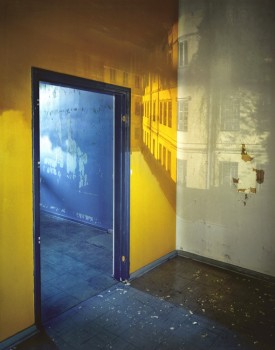
Speaking House #12, 2006. Photo: Marja PIrilä
A camera obscura (‘darkened room’) is the optical device that made photography possible; it is a box – or a room – with a hole in one side. Photographer Marja Pirilä has been using this method as a tool for almost 20 years. The book Carried by Light spans more than 30 years of her photography.
In the book artist and researcher Jyrki Siukonen notes in his essay ‘Eyes and Cameras’ that ‘in photographing spaces Pirilä also depicts people. The dreams continue on the walls of the empty building, as if after the people the house had become like them and were dreaming the dreams itself.’
Photographs and text extracts from Carried by Light by Marja Pirilä (Musta Taide, 2014)
Instant erudition, or, who are you kidding?
2 September 2014 | Articles, Letter from the Editors, Non-fiction
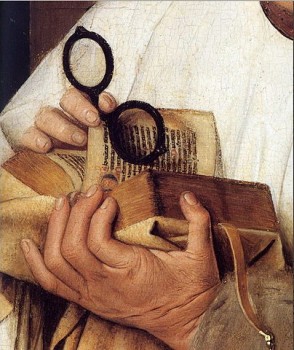
Time to read? Detail from Madonna with Canon van der Paele by Jan van Eyck (1439. The Groeninge Museum, Brugge). Wikipedia
In a recent ‘Saturday essay’ in the Helsingin Sanomat newspaper (9 August) journalist Oskari Onninen ponders the moral dilemma of pretending to be erudite. For example, who has the time to read books these days? ‘The Woolfs remain unread, Bergmans unwatched’, Onninen writes.
Our consumerist lifestyle forces us to follow the trends of ever-expanding, multiplying forms of entertainment. However, it is apparent that the need to know about culture in order to pass as a cultured, well-informed citizen still exists, to some extent at least.
According to Onninen, there is less and less time for unproductivity. ‘If one looks for measurable cost-benefit results from the reading of heavyweight fiction, the act of reading will certainly not always be worthwhile.’ Consuming art (reading books, going to art exhibitions, watching plays) requires time and effort, and how productive is that? More…
Rooms with views
21 August 2014 | Extracts, Non-fiction
Most of us live in box-shaped houses; the long-prevailing laws of modernist architecture relate to cubes, geometry and masses. Together with an architect, artist Jan-Erik Andersson designed a leaf-shaped house for himself. Could it be both art and architecture? In his new book he takes a look at non-cubical buildings in Finland and beyond, attempting to define what makes ‘wow factor architecture’: good architecture requires freedom from strict aesthetic rules.
Extracts from the chapter entitled ‘Det inre rummet’ (‘The inner room’) in Wow. Åsikter om finländsk arkitektur (‘Wow. Thoughts on Finnish architecture’, Schildts & Söderströms, 2014)
I remember from my childhood in the 1960s how my brother and I each lay in our beds in a little room late in the evening and stared up at the ceiling, onto which the lights from cars outside cast patterns. The patterns were constantly changing, they were like the doors of imagination onto eternity. Along with the hum of the engines they lulled me into a kind of half-stupor.
During the days the floor of the room grew to a town as we threw ourselves into a world of adventures and sped around with Formula 1 cars. Or the waste-paper bin was squeezed into a corner between the bookshelf and the wall, and the room took on the dimensions of a basketball court.
When defining a room it is difficult to distinguish between the outer, physical room, and the inner room formed by your consciousness. More…
The many arms of Krishna
14 August 2014 | Extracts, Non-fiction
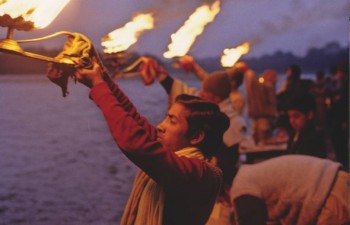
A feast by the Ganges. Photo from Pirjo Honkasalo’s film Atman
Cinematographer, camerawoman and director Pirjo Honkasalo has travelled and filmed widely – Japan, Estonia, India, Chechnya, Ingushetia, Russia – and her documentary films in particular have gained fame. American film critic John Anderson interviews Honkasalo; they talk about her documentary film Atman (1996) about a pilgrimage in India.
Edited extracts from Armoton kauneus. Pirjo Honkasalon elokuvataide (‘Merciless beauty. The film art of Pirjo Honkasalo’, Siltala, 2014; translated from English into Finnish by Leena Tamminen)
You can almost catch a whiff of the Ganges watching Atman [Hindu term, ‘self’], a documentary film in which religious pilgrimage, devotion, exhilaration and hysteria compete with tormented bodies, physical mortification, corpses, pollution and the acrid smoke of ritual cremation for domination of the viewer’s senses. The fact that it won the top prize at the International Documentary Film Festival Amsterdam in 1996 proves there is, if not justice, then good taste in the world. With all due respect to her previous work, Atman signified the full manifestation of Honkasalo’s genius.
What is it about? Eternity. Also, Jamana Lal: a member of the low-caste of Baila, a wifeless, crippled devotee of Lord Shiva whose mother has died, and who must – according to Hindu tradition – take her ashes from the ostensible mouth of the Ganges to the foothills of the Himalayas. More…
Harri Kalha: Muodon vuoksi. Lasin ja keramiikan klassikot [For form’s sake. The classics of glass and ceramics]
24 June 2014 | Mini reviews, Reviews
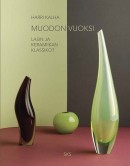 Muodon vuoksi. Lasin ja keramiikan klassikot
Muodon vuoksi. Lasin ja keramiikan klassikot
[For form’s sake. The classics of glass and ceramics]
Helsinki: The Finnish Literature Society, 2013. 335 pp., ill.
ISBN 978-952-222-402-6
€75, hardback
This handsome, massive work introduces objects of glass and ceramics from the Finnish ‘golden age’ of the 1940s, 1950s and 1960s. Artist-designers Kaj Franck, Tapio Wirkkala, Toini Muona, Timo Sarpaneva and Kyllikki Salmenhaara were awarded three prizes at the Milan Triennale, Rut Bryk and Birger Kaipiainen two, but the number of designers whose works have become classics without these prizes is naturally much larger. The art historian and author Harri Kalha records the exceptional development of industrial design. In postwar Finland, with scarce resources, art and mass production entwined, resulting in high-standard objects of glass and ceramics gaining international fame and becoming part of international modernism. The businessman Kyösti Kakkonen became interested in Finnish design in the 1990s, and now his private collection consists of thousands of objects, from which Kalha has made his choices for the book. More than two hundred photographs, by Niclas Warius, pay tribute to the materials, shapes and colours of the objects as light is reflected from the surfaces, making them appear three-dimensional, both real and dream-like. The printing, by Bookwell, matches the quality of the photography.
Fan-male?
29 March 2014 | This 'n' that
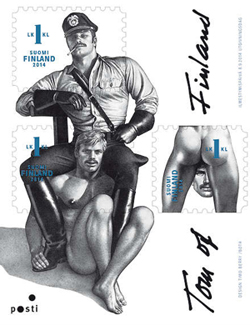 It is one of the enduring peculiarities of Finnish culture, along with the national enthusiasms for heavy metal music and the tango, that Tom of Finland, an erotic artist who specialised in stylised pencil images of muscular and well-endowed men wearing tight or little clothing, should be regarded as a national treasure.
It is one of the enduring peculiarities of Finnish culture, along with the national enthusiasms for heavy metal music and the tango, that Tom of Finland, an erotic artist who specialised in stylised pencil images of muscular and well-endowed men wearing tight or little clothing, should be regarded as a national treasure.
Even more startling, according to our friends abroad, is the news that a collection of Tom’s images is to be issued as postage stamps in September this year, when an exhibition opens in the Postal Museum in Tampere. ‘Sealed with a Secret – Correspondence of Tom of Finland’ displays Laaksonen’s correspondence from the early 1940s to 1991.
As the Finnish post office, Itella Posti, remarks in its press release, Tom of Finland, or Touko Laaksonen (1920–1991), is one of the most well-known Finnish artists around the world. The images selected – which include a pair of buttocks with a moustached face peeking out from between the legs and a man in military uniform entwined with a naked one – stick to the tamer side of Tom’s work, but their stereotypical homoeroticism will nevertheless be, let’s say, striking additions to the envelopes on which they appear.
According to Timo Berry, the graphic artist who made the selection, the stamps portray ‘a sensual life force and being proud of oneself. There is never too much of that in this northern country.’
Opinions will differ as to the artistic merits of Tom of Finland’s work, but one thing is certain: it’s decidedly top-shelf material. The Finnish post office website features a discussion of whom one would send which stamps to: you wouldn’t, obviously, send Tom to your maiden aunt in the countryside, but the conversation doesn’t examine the fact that the images will not only be viewed by the addressee. How would you explain the pictures to your small children, for example?
Postage stamps are, traditionally, regarded as an expression of national identity – in that case it’s debatable what these are expressing, as Finland is not conspicuously friendly to the gay community. There is no gay marriage, and you can only legally change your gender after surgical sterilisation.
So why issue Tom of Finland as public art? We’re stumped. (On the other hand, we’re not convinced you need to regard stamps as an expression of national identity at all…)
Answers on a postcard, please. You choose the stamps. (Tom’s stamps are self-adhesive, by the way. You don’t have to, ahem, lick their backsides.)
Remembrance
29 March 2014 | This 'n' that
 This year is the centenary of Tove Jansson (1914–2001), the painter, caricaturist, comic strip artist, illustrator and author of books for both children and adults, and, what made her name internationally, the creator of the Moomins. Today, her Moomin books are available in 40 languages.
This year is the centenary of Tove Jansson (1914–2001), the painter, caricaturist, comic strip artist, illustrator and author of books for both children and adults, and, what made her name internationally, the creator of the Moomins. Today, her Moomin books are available in 40 languages.
One sunny April day, walking through the atmospheric old Hietaniemi cemetery by the sea in Helsinki, a charming little bronze statue on top of a narrow granite column caught my eye.
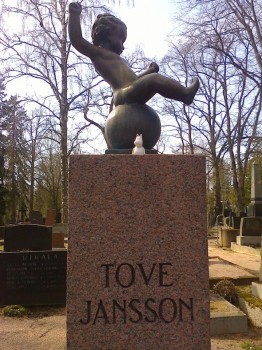
Family grave: sculpture by Victor Jansson
It was a small child balancing on a ball, waving its arms and legs joyously in the air. On a closer look, there was something white attached to the statue: it was a tiny white plastic Moomin.
On the Janssons’ family grave the first little blue flowers had just risen to the surface to bask in the early spring sun. Tove’s father was the sculptor Victor Jansson, her mother was the cartoonist and artist Signe Hammarsten Jansson.
Perhaps one of Tove’s fans had chosen this way of paying homage to the creator of the unique Moomin universe.
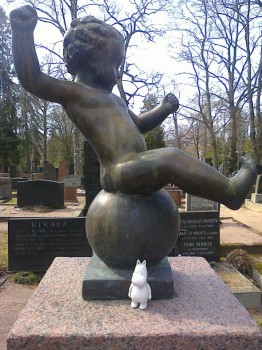
At your service
19 March 2014 | Extracts, Non-fiction
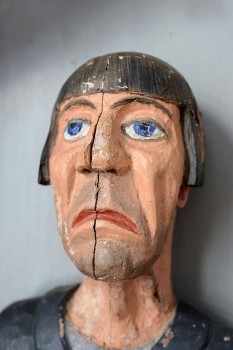
Melancholy man: detail of the almsman in Pomarkku, carved by Artturi Kaseva in the 1920s. Photo: Aki Paavola
Old men carved of wood have stood outside churches since the 17th century, begging for money to be given to the poor and the sick of the parish. These almsmen, or men-at-alms, mostly represented a disabled soldier; the tradition is not known elsewhere. Some 40 of the still surviving almsmen (there is one almswoman) were assembled for an exhibition in Kerimäki – in the world’s largest Christian wooden church – in summer 2013. The surviving specimens were hunted down and photographed by Aki Paavola for the book Vaivaisukkojen paluu (‘The return of the almsmen’). Otso Kantokorpi asks in the title of his introduction: are men-at-alms pioneers of ITE (from the words itse tehty elämä, ‘self-made life’; the English-language term is ‘outsider art’) or a disappearing folk tradition?
Many a church or belfry wall, particularly in Ostrobothnia, has been decorated – and is often still decorated – with a wooden human figure. Often they stand beneath a decorative canopy, sometimes accompanied by an encouraging phrase: He that hath pity upon the poor lendeth unto the LORD. They have been called men-at-alms or boys-at-alms. More…
Like it, or else
23 January 2014 | Non-fiction, Tales of a journalist
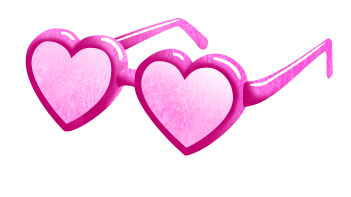
Illustration: Joonas Väänänen
Hitting the ‘like’ button is not only boring but also working its way from Facebook deeper into society, says Jyrki Lehtola. Surely there must be some other way of solving the world’s problems?
At the end of the autumn the theatre critic of the Helsingin Sanomat newspaper panned Sofi Oksanen’s stage adaptation of her novel Kun kyyhkyset katosivat (‘When the doves disappeared’, 2013).
That’s life. Artists struggle with their projects, sometimes for years. Then a critic takes a glance at the result and crushes it in a matter of hours.
Then there’s a huff about unfairness, the use of power and all the things artists blow off steam about when they feel that their creations have been treated unfairly. The debate is held between injured authors and sometimes the critic, but generally few others participate, and just as well. More…
